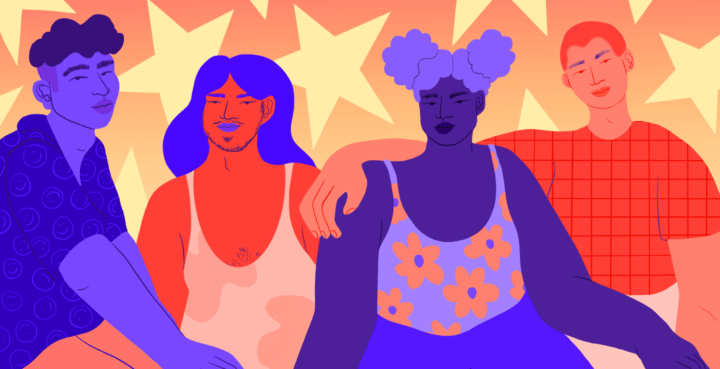Last Updated January 2024
Top-Line Facts & Statistics
- Suicide is the second leading cause of death among young people aged 10 to 14, and the third leading cause of death among 15-24 year olds (Centers for Disease Control and Prevention, 2022). Lesbian, gay, bisexual, transgender, queer, and questioning (LGBTQ+) young people are at significantly increased risk.
- LGBTQ+ young people are more than four times as likely to attempt suicide than their peers (Johns et al., 2019; Johns et al., 2020).
- The Trevor Project estimates that more than 1.8 million LGBTQ+ young people (ages 13-24) seriously consider suicide each year in the U.S. — and at least one attempts suicide every 45 seconds.
- The Trevor Project’s 2023 U.S. National Survey on the Mental Health of LGBTQ Young People found that 41% of LGBTQ+ young people seriously considered attempting suicide in the past year, including roughly half of transgender and nonbinary youth.
The Importance of Intersectionality
- Intersectionality is a framework for understanding how interdependent and multidimensional social identities at the individual level, such as race/ethnicity, gender, and sexuality, are shaped by interlocking systems of privilege and oppression at the societal level, such as heterosexism, cisgenderism, and racism (Crenshaw, 1991).
- This intersection of identities may, in turn, present distinct stressors for some LGBTQ+ young people compared to others, and minority stress may be most persistent and problematic for youth who occupy multiple marginalized social positions (Cyrus, 2017).
- That said, largely due to sample size limitations, researchers often fail to examine within-group differences among LGBTQ+ young people, limiting our understanding of within-group disparities in suicidal thoughts and behaviors.
- However, existing research points to increased disparities for bisexual youth, transgender and nonbinary youth, and LGBTQ+ youth of color.
Mental Health Disparities Across Social Identities
- Bisexual Youth Mental Health Facts
- Data show that bisexual youth, or those who have the capacity to form attraction and/or relationships to more than one gender, report higher rates of depressed mood, bullying, sexual assault, and physical harm
- According to The Trevor Project’s analysis of CDC data, almost half (48%) of bi young people seriously considered attempting suicide in the past year, and 27% attempted suicide. Among gay or lesbian youth, 37% seriously considered suicide and 19% attempted. And among straight youth, 14% seriously considered suicide and 6% attempted suicide.
- These suicide risk disparities among bi youth also remain constant across gender identity and race/ethnicity.
- Transgender and Nonbinary Young People Mental Health Facts
- Transgender and nonbinary young people face elevated risk for depression, thoughts of suicide, and attempting suicide compared to those who are cisgender and straight, including cisgender members of the LGBTQ+ community.
- A 2020 peer-reviewed study by The Trevor Project’s researchers, published in the Journal of Adolescent Health, found that transgender and nonbinary youth were 2 to 2.5 times as likely to experience depressive symptoms, seriously consider suicide, and attempt suicide compared to their cisgender LGBQ peers.
- LGBTQ+ Young People of Color Mental Health Facts
- The Trevor Project’s 2023 national survey found that nearly all LGBTQ+ young people of color reported higher rates of attempting suicide than their white peers in the past year. Among the more than 28,000 LGBTQ+ young people surveyed, 11% of white youth attempted suicide compared to 22% of Native/Indigenous youth, 18% of Middle Eastern/Northern African youth, 16% of Black youth, 17% of multiracial youth, 15% of Latinx youth, and 10% of Asian/Pacific Islander youth.
- Across race/ethnicity, Native/Indigenous youth who are Two-Spirit/LGBTQ+ consistently report the highest suicide risk.
- Nearly a quarter of Indigenous LGBTQ+ young people (23%) reported attempting suicide in the past year, compared to 14% among the overall sample of LGBTQ+ young people.
- In particular, Black transgender and nonbinary young people report disproportionate rates of suicide risk — with 58% seriously considering suicide and 1 in 4 (25%) attempting suicide in the past year.
- These disparities highlight the devastating impacts of historical and ongoing oppression and trauma inflicted on Black, Indigenous, and people of color.
Some Key Risk Factors for Suicide among LGBTQ+ Young People
- Minority Stress
- The Minority Stress Model, one of the most predominant theories used to explain mental health disparities experienced by LGBTQ+ individuals, suggests that experiences of LGBTQ+-based victimization — and the internalization of these experiences and anti-LGBTQ+ messages — can compound and produce negative mental health outcomes and increase suicide risk among LGBTQ+ individuals (Meyer, 2003).
- A 2021 peer-reviewed study by The Trevor Project’s researchers, published in the American Journal of Community Psychology, found that greater experiences of minority stress experiences are associated with increased odds of attempting suicide. LGBTQ+ young people who reported experiencing four types of minority stress — LGBTQ+-based physical harm, discrimination, housing instability, and change attempts by parents — were 12 times at greater odds of attempting suicide compared to youth who experienced none.
- Rejection and a Lack of Social Support & Affirming Spaces
- Research suggests that among LGBTQ+ young people, only one-third experience parental acceptance, with an additional one-third experiencing parental rejection, and the final one-third not disclosing their LGBTQ+ identity until they are adults (Katz-Wise et al., 2015). Another study found that LGB young adults who report high levels of parental rejection are eight times more likely to report attempting suicide and six times more likely to report high levels of depression (Ryan et al., 2009).
- Many LGBTQ+ young people lack access to affirming spaces, with only 38% of LGBTQ+ youth reporting that their home is LGBTQ+-affirming and just over half saying that their school is LGBTQ+-affirming. Just over 1 in 3 transgender and nonbinary youth found their home to be gender-affirming, and 52% found their school to be affirming. The Trevor Project’s research consistently finds that LGBTQ+ young people report lower rates of attempting suicide when they have access to LGBTQ+-affirming spaces.
- Physical Harm & Bullying Facts
- 24% of LGBTQ+ young people reported that they have been physically threatened or harmed, and those who did attempted suicide at nearly triple the rate of those who did not in the past year.
- The Trevor Project’s research has also found that 52% of LGBTQ+ youth who were enrolled in middle or high school reported being bullied either in person or electronically in the past year, and those who were bullied had three times greater odds of attempting suicide in the past year.
- Discrimination Facts
- 60% of LGBTQ+ young people report that they had experienced discrimination based on their sexual orientation or gender identity at least once in their lifetime, and those who did attempted suicide at more than twice the rate of those who did not in the past year.
- A 2020 peer-reviewed study by The Trevor Project’s researchers, published in the Journal of Adolescent Health, found that transgender and nonbinary youth who report experiencing discrimination based on their gender identity had more than double the odds of attempting suicide in the past year compared to those who did not experience discrimination based on their gender identity.
- Conversion Therapy Facts
- A 2020 peer-reviewed study by The Trevor Project’s researchers, published in the American Journal of Public Health, found that young people who reported undergoing conversion therapy were more than twice as likely to report having attempted suicide and more than 2.5 times as likely to report multiple suicide attempts in the past year.
- According to The Trevor Project’s 2023 national survey, 15% of LGBTQ+ young people reported being threatened with or subjected to conversion therapy, including nearly 1 in 5 transgender and nonbinary young people
Some Key Protective Factors for Suicide among LGBTQ+ Young People
- The Impact of Social Support and Acceptance from Adults and Peers
- LGBTQ+ young people with at least one accepting adult in their life report significantly lower rates of attempting suicide.
- A 2021 peer-reviewed study by The Trevor Project’s researchers, published in Transgender Health, found that transgender and nonbinary youth who reported gender identity acceptance from adults and peers had significantly lower odds of attempting suicide in the past year.
- LGBTQ+ young people who felt high social support from their family reported attempting suicide at less than half the rate of those who felt low or moderate social support.
- LGBTQ+ young people who live in a community that is accepting of LGBTQ+ people reported much lower rates of attempting suicide than those who do not.
- The Impact of Affirming Spaces and Activities, Especially at School
- The Trevor Project’s research has found that LGBTQ+ young people who found their school and home to be LGBTQ+-affirming reported lower rates of attempting suicide.
- LGBTQ+ young people who report the presence of trusted adults in their school have higher levels of self-esteem (Dessel et al., 2017) and access to supportive peers is protective against anxiety and depression, including among those who lack support from their family (Parra et al., 2018).
- Schools also offer young people the ability to participate in extracurricular activities and clubs, which have been found to promote positive youth development (Eccles et al., 2003). The presence of Gender and Sexualities Alliances (GSAs) has been found to significantly reduce the risk for depression and increase well-being among LGBTQ+ young people and young adults (Toomey et al., 2011).
- The Impact of Policies and Practices that Support Transgender and Nonbinary Youth
- Transgender and nonbinary young people attempt suicide less when their pronouns are respected, when they are allowed to officially change the gender marker on their legal documents, and when they have access to spaces (online, at school, and home) that affirm their gender identity.
- Transgender and nonbinary young people who reported having pronouns respected by all or most people in their lives attempted suicide at half the rate of those who did not have their pronouns respected.
- A 2022 peer-reviewed study by The Trevor Project researchers, published in the International Journal of Environmental Research and Public Health, found that transgender and nonbinary young people who had changed their legal documents reported significantly lower rates of attempting suicide in the past year compared to those who had not.
- Gender-affirming medical care, such as hormone therapy, is associated with positive mental health outcomes including showing promise for reducing suicide risk. A 2021 peer-reviewed study by The Trevor Project’s researchers, published in the Journal of Adolescent Health, found that gender-affirming hormone therapy is significantly related to lower rates of depression, suicidal thoughts, and suicide attempts among transgender and nonbinary young people.
References
Centers for Disease Control and Prevention (CDC). (2022). Underlying Cause of Death by Single Race 2018-2021 on CDC WONDER Online Database. Accessed at http://wonder.cdc.gov/ucd-icd10-expanded.html.
Crenshaw, K. (1991). Mapping the margins: Intersectionality, identity politics, and violence against women of color. Stanford Law Review, 43(6), 1241–1299.
Cyrus, K. (2017). Multiple minorities as multiply marginalized: Applying the minority stress theory to LGBTQ people of color. Journal of Gay & Lesbian Mental Health, 21(3), 194–202.
DeChants, J. P., Price, M. N., Green, A. E., Davis, C. K., & Pick, C. J. (2022). Association of updating identification documents with suicidal Ideation and attempts among transgender and nonbinary youth. International Journal of Environmental Research and Public Health, 19(9), 5016.
DeChants, J.P., Price, M.N., Nath, R., Hobaica, S., & Suffredini, K.(2023). The Mental Health and Well-Being of Indigenous LGBTQ Young People. The Trevor Project.
Dessel, A. B., Kulick, A., Wernick, L. J., & Sullivan, D. (2017). The importance of teacher support: Differential impacts by gender and sexuality. Journal of Adolescence, 56, 136-144.
Eccles, J. S., Barber, B. L., Stone, M., & Hunt, J. (2003). Extracurricular activities and adolescent development. Journal of Social Issues, 59(4), 865-889.
Green, A. E., DeChants, J. P., Price, M. N., & Davis, C. K. (2021). Association of gender-affirming hormone therapy with depression, thoughts of suicide, and attempted suicide among transgender and nonbinary youth. Journal of Adolescent Health, 1–7.
Green, A. E., Price, M. N., & Dorison, S. H. (2021). Cumulative minority stress and suicide risk among LGBTQ youth. American Journal of Community Psychology, 1–12.
Green, A. E., Price-Feeney, M., & Dorison, S.H. (2019). National Estimate of LGBTQ Youth Seriously Considering Suicide. New York, New York: The Trevor Project.
Green, A. E., Price-Feeney, M., & Dorison, S. H. (2021). Association of sexual orientation acceptance with reduced suicide attempts among lesbian, gay, bisexual, transgender, queer, and questioning youth. LGBT health, 8(1), 26–31.
Green, A. E., Price-Feeney, M., Dorison, S. H., & Pick, C. J. (2020). Self-reported conversion efforts and suicidality among US LGBTQ youths and young adults, 2018. American Journal of Public Health, 110(8), 1221–1227.
Hedegaard, H., Curtin, S.C., & Warner, M. (2018). Suicide mortality in the United States, 1999–2017. National Center for Health Statistics Data Brief, 330, Hyattsville, MD: National Center for Health Statistics.
Johns, M. M., Lowry, R., Andrzejewski, J., Barrios, L. C., Zewditu, D., McManus, T., et al. (2019). Transgender identity and experiences of violence victimization, substance use, suicide risk, and sexual risk behaviors among high school student–19 states and large urban school districts, 2017. Morbidity and Mortality Weekly Report, 68(3), 65-71.
Johns, M. M., Lowry, R., Haderxhanaj, L. T., et al. (2020). Trends in violence victimization and suicide risk by sexual identity among high school students — Youth Risk Behavior Survey, United States, 2015–2019. Morbidity and Mortality Weekly Report, 69,(Suppl-1):19–27.
Katz-Wise, S. L., Rosario, M., & Tsappis, M. (2016). Lesbian, gay, bisexual, and transgender youth and family acceptance. Pediatric Clinics of North America, 63(6), 1011-1025.
Meyer, I. H. (2003) Prejudice, social stress, and mental health in lesbian, gay, bisexual populations: Conceptual issues and research evidence. Psychological Bulletin, 129(5), 674-697.
Parra, L. A., Bell, T. S., Benibgui, M., Helm, J. L., & Hastings, P. D. (2018). The buffering effect of peer support on the links between family rejection and psychosocial adjustment in LGB emerging adults. Journal of Social and Personal Relationships, 35(6), 854-871.
Price-Feeney, M., Green, A. E., & Dorison, S. (2020). Understanding the mental health of transgender and nonbinary youth. Journal of Adolescent Health, 66(6), 684–690.
Price-Feeney, M., Green, A. E., & Dorison, S. (2020). All Black Lives Matter: Mental Health of Black LGBTQ Youth. New York, New York: The Trevor Project.
Price-Feeney, M., Green, A. E., & Dorison, S. H. (2021). Impact of bathroom discrimination on mental health among transgender and nonbinary youth. Journal of Adolescent Health, 68(6), 1142–1147.
Ryan, C., Huebner, D., Diaz, R. M., & Sanchez, J. (2009). Family rejection as a predictor of negative health outcomes in white and Latino lesbian, gay, and bisexual young adults. Pediatrics, 123(1), 346-352.
The Trevor Project. (2019). Research brief: Bisexual youth experience. https://www.thetrevorproject.org/research-briefs/bisexual-youth-experience/
The Trevor Project. (2019). Research brief: Accepting adults reduce suicide attempts among LGBTQ youth. https://www.thetrevorproject.org/research-briefs/accepting-adults-reduce-suicide-attempts-among-lgbtq-youth/
The Trevor Project. (2020). 2020 national survey on LGBTQ youth mental health. https://www.thetrevorproject.org/wp-content/uploads/2020/07/The-Trevor-Project-National-Survey-Results-2020.pdf
The Trevor Project. (2020). Research brief: LGBTQ & gender-affirming spaces. https://www.thetrevorproject.org/research-briefs/lgbtq-gender-affirming-spaces/
The Trevor Project. (2021). Estimate of how often LGBTQ youth attempt suicide in the U.S. https://www.thetrevorproject.org/research-briefs/estimate-of-how-often-lgbtq-youth-attempt-suicide-in-the-u-s/
The Trevor Project. (2021). Research brief: Bullying and suicide risk among LGBTQ youth. https://www.thetrevorproject.org/research-briefs/bullying-and-suicide-risk-among-lgbtq-youth/
The Trevor Project. (2021). 2021 national survey on LGBTQ youth mental health. https://www.thetrevorproject.org/wp-content/uploads/2021/05/The-Trevor-Project-National-Survey-Results-2021.pdf
The Trevor Project. (2022). 2022 national survey on LGBTQ youth mental health. https://www.thetrevorproject.org/survey-2022/assets/static/trevor01_2022survey_final.pdf
The Trevor Project. (2023). 2023 U.S. national survey on the mental health of LGBTQ young people. https://www.thetrevorproject.org/survey-2023/assets/static/05_TREVOR05_2023survey.pdf
Toomey, R. B., Ryan, C., Diaz, R. M., & Russell, S. T. (2011). High school gay–straight alliances (GSAs) and young adult well-being: An examination of GSA presence, participation, and perceived effectiveness. Applied Developmental Science, 15(4), 175-185.
Help us continue to provide 24/7 support to LGBTQ+ young people and empower allies to deepen their commitment through advocacy, education, and affirming content.


